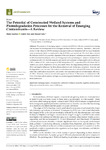Mostrar o rexistro simple do ítem
The Potential of Constructed Wetland Systems and Photodegradation Processes for the Removal of Emerging Contaminants—A Review
| dc.contributor.author | Sánchez Núñez, Marta | |
| dc.contributor.author | Ruiz, Isabel | |
| dc.contributor.author | Soto, Manuel | |
| dc.date.accessioned | 2022-10-19T19:04:25Z | |
| dc.date.available | 2022-10-19T19:04:25Z | |
| dc.date.issued | 2022 | |
| dc.identifier.citation | Sánchez, M.; Ruiz, I.; Soto, M. The Potential of Constructed Wetland Systems and Photodegradation Processes for the Removal of Emerging Contaminants—A Review. Environments 2022, 9, 116. https://doi.org/10.3390/environments9090116 | es_ES |
| dc.identifier.issn | 2076-3298 | |
| dc.identifier.uri | http://hdl.handle.net/2183/31844 | |
| dc.description | This article belongs to the Topic Soil and Water Pollution Process and Remediation Technologies | es_ES |
| dc.description.abstract | [Abstract] The presence of emerging organic contaminants (EOCs) in the environment is increasing and requires the development of technologies for their effective removal. Therefore, a literature review on the behavior of EOCs during municipal wastewater treatment, both in major treatment systems and particularly in constructed wetlands (CWs), was carried out. The study also reviewed the behavior of EOCs in anaerobic digesters (ADs) and advanced oxidation processes, particularly in TiO2-based photocatalysis, which are being proposed as promising pre- and post-treatments for combination with CW. The following ten compounds were screened: acetaminophen (ACE), ofloxacin (OFL), caffeine (CAF), carbamazepine (CBZ), ketoprofen (KET), ibuprofen (IBU), diclofenac (DCL), clofibric acid (ACB), bisphenol A (BPA), and sotalol (SOT). The degradation pathways of the selected EOCs are largely influenced by their physicochemical and biochemical properties. Sorption and biodegradation are the main elimination mechanisms found in AD and CW treatment systems, where the combination of anaerobic and aerobic environments improves the elimination efficiency of EOCs. However, various contaminants appear recalcitrant. In this sense, in combination with CWs, TiO2-based photocatalysis emerges as a promising post-treatment for advanced EOC removal from wastewater. | es_ES |
| dc.description.sponsorship | This research was funded by the Spanish Ministerio de Economía y Competitividad through project CTQ2015-71238-R (MINECO/FEDER) and by the Xunta de Galicia through project GPC ED431B 2019/44 | es_ES |
| dc.description.sponsorship | Xunta de Galicia; ED431B 2019/44 | es_ES |
| dc.language.iso | eng | es_ES |
| dc.publisher | MDPI | es_ES |
| dc.relation | info:eu-repo/grantAgreement/MINECO/Plan Estatal de Investigación Científica y Técnica y de Innovación 2013-2016/CTQ2015-71238-R/ES/SOSTENIBILIDAD DE RECURSOS HIDRICOS: REDUCCION DE CONTAMINANTES ORGANICOS PERSISTENTES MEDIANTE UN SISTEMA COMBINADO DE HUMEDALES Y FOTOCATALISIS HETEROGENEA/ | |
| dc.relation.uri | https://doi.org/10.3390/environments9090116 | es_ES |
| dc.rights | Atribución 4.0 Internacional (CC BY 4.0) | es_ES |
| dc.rights.uri | https://creativecommons.org/licenses/by/4.0/ | * |
| dc.subject | Emerging organic contaminants | es_ES |
| dc.subject | Constructed wetlands | es_ES |
| dc.subject | Anaerobic digesters | es_ES |
| dc.subject | Photocatalysis | es_ES |
| dc.subject | TiO2 | es_ES |
| dc.subject | Removal mechanisms | es_ES |
| dc.subject | Removal efficiency | es_ES |
| dc.title | The Potential of Constructed Wetland Systems and Photodegradation Processes for the Removal of Emerging Contaminants—A Review | es_ES |
| dc.type | info:eu-repo/semantics/article | es_ES |
| dc.rights.access | info:eu-repo/semantics/openAccess | es_ES |
| UDC.journalTitle | Environments | es_ES |
| UDC.volume | 9 | es_ES |
| UDC.issue | 9 | es_ES |
| UDC.startPage | 116 | es_ES |
| dc.identifier.doi | 10.3390/environments9090116 |
Ficheiros no ítem
Este ítem aparece na(s) seguinte(s) colección(s)
-
GI-EnQA-Artigos [16]






